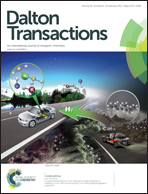Varying electronic structural forms of ruthenium complexes of non-innocent 9,10-phenanthrenequinonoid ligands†
Abstract
Bis(acetylacetonato)ruthenium complexes [Ru(acac)2(Q1–3)], 1–3, incorporating redox non-innocent 9,10-phenanthrenequinonoid ligands (Q1 = 9,10-phenanthrenequinone, 1; Q2 = 9,10-phenanthrenequinonediimine, 2; Q3 = 9,10-phenanthrenequinonemonoimine, 3) have been characterised electrochemically, spectroscopically and structurally. The four independent molecules in the unit cell of 2 are involved in intermolecular hydrogen bonding and π–π interactions, leading to a 2D network. The oxidation state-sensitive bond distances of the coordinated ligands Qn at 1.296(5)/1.289(5) Å (C–O), 1.315(3)/1.322(4) Å (C–N), and 1.285(3)/1.328(3) Å (C–O/C–N) in 1, 2 and 3, respectively, and the well resolved 1H NMR resonances within the standard chemical shift range suggest DFT supported variable contributions from valence formulations [RuIII(acac)2(Q˙−)] (spin-coupled) and [RuII(acac)2(Q0)], respectively. Complexes 1–3 exhibit one oxidation and two reduction steps with comproportionation constants Kc ∼ 107–1022 for the intermediates. The electrochemically generated persistent redox states 1n (n = 0, 1−, 2−) and 2n/3n (n = 1+, 0, 1−, 2−) have been analysed by UV-vis-NIR spectroelectrochemistry and by EPR for the paramagnetic intermediates in combination with DFT and TD-DFT calculations, revealing significant differences in the oxidation state distribution at the {Ru–Q} interface for 1n–3n. In particular, the diminished propensity of the NH-containing systems for reduction results in the preference for RuII(Q0) relative to RuIII(Q˙−) (neutral compounds) and for RuII(Q˙−) over the RuIII(Q2−) alternative in the case of the monoanionic complexes.


 Please wait while we load your content...
Please wait while we load your content...